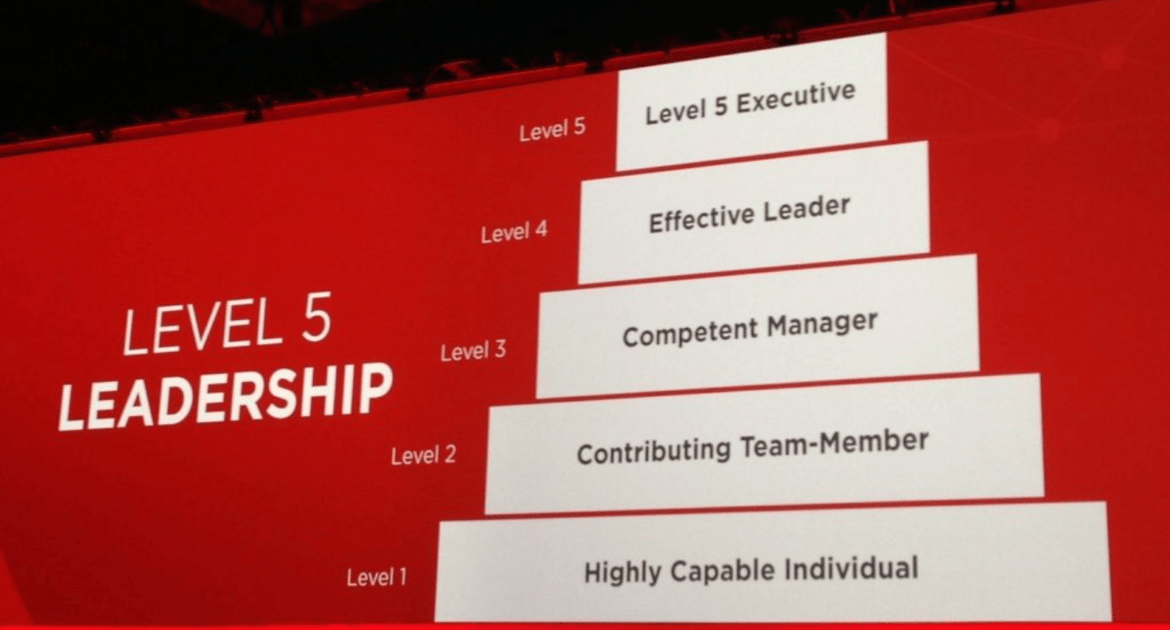Level 5 Leadership: The Ultimate Guide to Building High-Performing Teams
March 7, 2025 •Neale Lewis

When it comes to leadership, few models are as powerful as Jim Collins' concept of Level 5 Leadership, introduced in his groundbreaking book Good to Great. This framework identifies the key traits that separate good leaders from truly great ones. As a Scaling Up coach, I often see organisations plateau because their leadership teams struggle to make the leap from competent management to transformational leadership.
If you want to scale your business, create a high-performing team, and maximise your valuation, Level 5 Leadership is a game-changer. Let’s explore what it means and how you can develop these leadership traits to elevate your organisation.
What Is Level 5 Leadership?
Jim Collins defines Level 5 Leadership as the highest form of leadership, characterised by a unique blend of personal humility and professional will. It’s a striking contrast to the traditional image of the charismatic, ego-driven leader who commands the spotlight.
Level 5 Leadership Pyramid
Collins breaks leadership down into five levels:
- Highly Capable Individual – Possesses talent, knowledge, and skills needed to make meaningful contributions.
- Contributing Team Member – Works effectively with others in a team setting.
- Competent Manager – Organizes people and resources efficiently to achieve predetermined goals.
- Effective Leader – Catalyzes commitment to a clear and compelling vision, stimulating higher performance.
- Level 5 Executive – Builds enduring greatness by channeling ambition into the organisation rather than personal success.
The move from Level 4 to Level 5 is where leaders unlock the full potential of their teams and organisations.
How Level 5 Leadership Transforms Teams
1. From Ego to Servant Leadership
One of the biggest shifts you’ll notice in Level 5 Leaders is that their ego does not drive their decisions. Instead of seeking personal success and recognition, they are committed to the long-term success of the company.
❓ How to apply this:
- Shift from “I” to “we” language in meetings.
- Encourage and acknowledge team members for successes rather than taking credit.
- Make decisions based on what’s best for the company, not personal gain.
2. Unwavering Resolve: Do What Must Be Done
Level 5 Leaders don’t shy away from tough decisions. They lean into challenges with determination, executing what is necessary for long-term success—no matter how difficult.
💡 Example: When Darwin Smith became CEO at Kimberly-Clark, he made the radical decision to sell off paper mills and invest in consumer goods. His strategy transformed the company into a powerhouse.
❓ How to apply this:
- Be decisive. Evaluate your toughest organizational bottlenecks and commit to making bold strategic moves.
- Lead by example. If you expect excellence, ensure you demonstrate it first.
- Make the tough calls. If you know an employee or strategy is holding your company back, have the courage to address it.
3. The Right People in the Right Seats
Great teams don’t happen by accident. Level 5 Leaders prioritise People first, then Strategy. They focus on getting the right people on board before worrying about where the company is headed.
💡 Scaling Up Framework Alignment:
This aligns perfectly with Jim Collins’ “First Who…Then What” principle and the Function Accountability Chart (FACe) from Scaling Up.
❓ How to apply this:
- Use the Topgrading method to recruit A-players—those who align with your core values and thrive in their roles.
- Assess your leadership team every quarter. Would you enthusiastically rehire each of them?
- Coach adaptability. Help your team members grow into their roles instead of micromanaging them.
4. Confronting Brutal Facts (While Maintaining Hope)
Level 5 Leaders embrace the Stockdale Paradox—they confront harsh realities without losing faith that they will ultimately prevail.
❓ How to apply this:
- Have honest leadership meetings where you analyse weaknesses without sugarcoating them.
- Ask your team hard questions:
- Are we REALLY executing at our highest level?
- What are we avoiding that could become our downfall?
- Where are we wasting time, talent, or capital?
- Balance optimism with realism. Inspire confidence while acknowledging challenges.
5. Succession Planning & Lasting Legacy
Unlike traditional leaders who seek personal accolades, Level 5 Leaders focus on building something that lasts beyond them. They create systems, structure, and culture that continue thriving without their presence.
💡 Example: Companies like Southwest Airlines and Procter & Gamble thrive post-CEO because their leadership succession is built into the company DNA.
❓ How to apply this:
- Build a leadership pipeline—train and mentor emerging leaders in your company.
- Create processes that drive success. If your company can’t function without you, you aren’t a Level 5 Leader yet.
- Set a BHAG (Big Hairy Audacious Goal)! What long-term movement can you create within your company?
Final Thoughts: Scaling Up with Level 5 Leadership
The transition to Level 5 Leadership is about putting aside ego, quick wins, and personal ambition, and channeling all that energy into building a high-performing team and a company that thrives even without you.
Immediate Actions to Implement Level 5 Leadership in Your Organisation:
✅ Start using "we" more than "I" in meetings.
✅ Identify one tough decision you’ve been avoiding—commit to acting on it.
✅ Perform a People Audit—are the right people in the right seats?
✅ Develop a succession plan—who is the next leader you’re mentoring?
✅ Set a 10-year BHAG—what legacy do you want to leave?
The best leaders make themselves obsolete. Will you?

